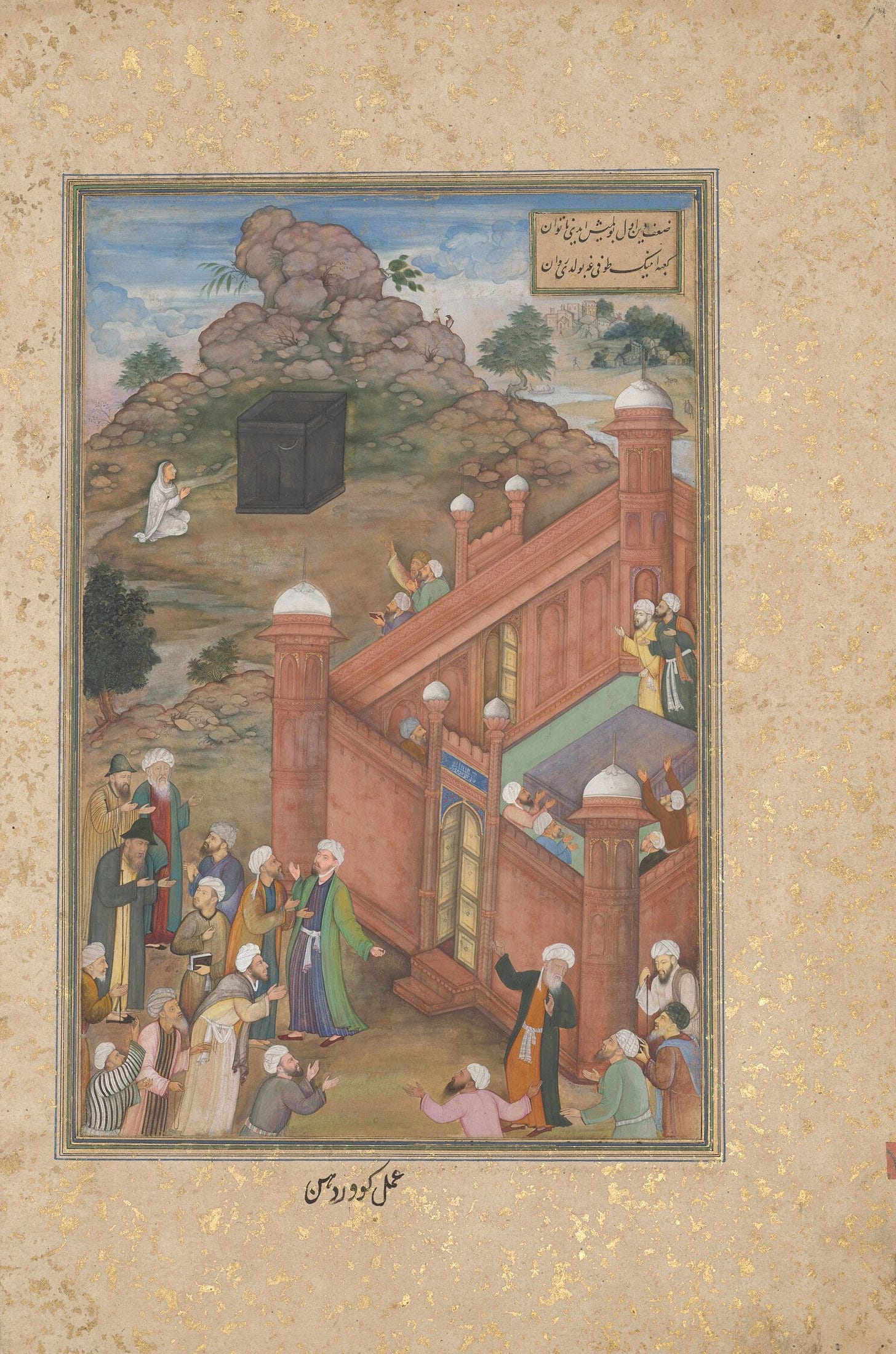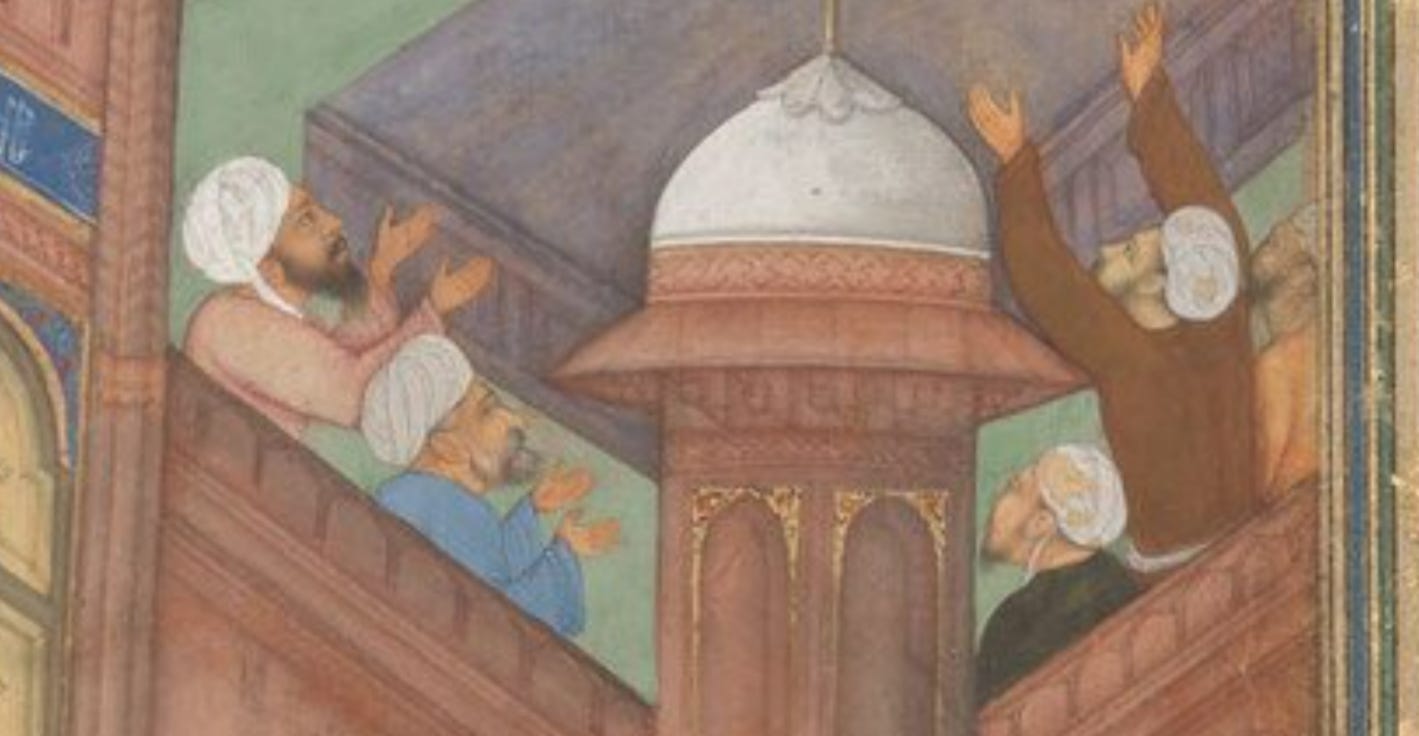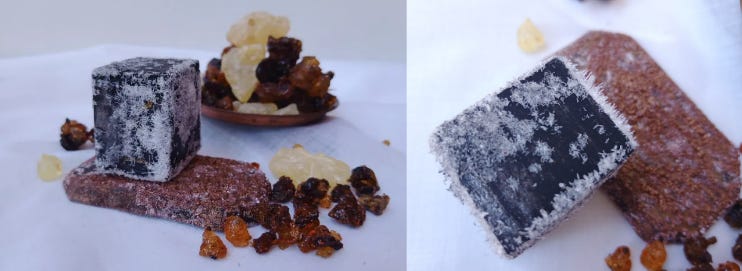
This folio was introduced to me by British-Pakistani curator Hammad Nasar nearly two years back. It was one among a number of Mughal and Rajput manuscripts and paintings he was due to bring out for his exhibition “Beyond the Page: South Asian Miniature Painting and Britain, 1600 to Now” last September at the Milton Keynes Gallery. He took me through a number of historically significant and artistically spectacular folios but this unassuming one stuck with me.

On preliminary reading, this illustration is amusing — the Kaaba has left its sacred place to meet the Saint Rabiyah al-Adawiyah, while the mullahs appear to be in shock. They can hardly believe their eyes! The Hindu artist, Govardhan, active between 1595–1640, serving under Akbar (Reign 11 February 1556 - 27 October 1605), had obviously never been to Mecca so perhaps he relied on descriptions of the Kaaba from those who had returned from their pilgrimage. Yet, he imagined the architecture and the landscape to be similar to North India. The Kaaba must have a red sandstone fort-like protective structure built around it, with grand arches, minarets and entrance gates from all four sides. Rocky hills, trees, rivers, and mossy-verdant scapes…
The Metropolitan Museum has a number of folios attributed to the same artist. One of the famous illustrations in their repository by Govardhan is of “Akbar with a Lion and Calf”:
On a close reading of this folio, I think, I was most moved by the premise that Govardhan so masterfully depicts— the Kaaba vanishes from its designated sacred space to appear for the one who seeks no reward for her virtue.
The destitution and suffering of Rabi'a of Basra (C. 714–801) is known through Sufi poetry. While I am not a historian, I still wished to engage with this folio and its premise of miracles through art, perfume and critique.
The museum description (that I am relying on for cursory reading) says:
“This painting depicts her pilgrimage to Mecca when God moved the Kaaba to meet her, a story told in much Sufi poetry. In the foreground, is another Muslim saint, Ibrahim bin Adam of Balkh (modern day Afghanistan) (d.770). Having given up his kingdom and wealth to become a wandering dervish he arrives at the Masjid al-Haram (sacred enclosure) of Mecca after a fourteen year journey crossing the desert in prayer, only to find the Kaaba gone. […] He depicts the figures in contemporary Mughal clothing and the Masjid al-Haram as a Mughal red sandstone mosque. The face of Saint Rabiah has suffered paint loss to the extent that the under drawing is visible.”
Several stories narrate the trials of Rabiyah, her life of slavery, suffering, devotion, and her difficult seven year journey towards the Mecca. One version says, she was so exhausted and famished by the time she arrived in Mecca, she was unable to make her way any further. Another version says, she was denied permission to complete her pilgrimage on account of being a women by the (gate)keepers of the Kaaba. Either way it did not matter. Admissible or not, Rabiyah’s beloved defies the laws of physics to meet her.
In broad strokes, this is a parable, as old as time, about the powerful and the powerless, the establishment that seeks conformity shown in contrast to the outlier going her own way; one seeks knowledge in order to establish authority and control, the other seeks a kernel of truth for its own sake. In between the two is the dialectics of divine love, mercy and intervention.
So far as I can confirm, this Mughal folio was brought out of the vaults of the Royal Collection Trust for the first time for public display. Considering how much cultural and artistic wealth is hidden away, rarely brought out of storage due to myriad concerns around conservation and perpetual lack of funding, I wondered what it meant for such a depiction of the Kaaba to be on view. How might it be placed and accessed precisely? What if the Kaaba could come out of the painting in physical form to meet its yearning public?
Last year (March 2023), I was in a specially prolific phase inspired by imagery of 18th century art from the royal courts of Udaipur that were on public display at the Smithsonian in USA. I carved out clouds that resembled the ones in paintings, from soap blocks, painting them and then sealing them up into soap blocks that I offered as small-edition-reparations to the Indian public that could not access those artworks, not even in image form, so they could possess pieces of 18th century cumulus at the very least. The American institution got enraged, hurled an accusation without inquiry of their copyrights being in violation and threatened to shut down my Instagram account thereby directly impacting my livelihood here as an artist in India. I addressed the issue (Wearable Anger) but I will very bluntly state that academic-brahmins and museum-mullahs don’t get to dictate who can or cannot engage with (art) history. Such knowledge-hoarding folk belonging to this professional caste deserve our unvarnished critique and contempt. The recent spate of Euramerican institution-alignment with white-supremacy via silence, active complicity, preemptive censorship and cancellation of discourse, only proves my point.
As I was already engaged with soap as a pliable sculptural form, as well as a conceptual medium of purity, I attempted to reconstruct Govardhan’s composition. Several centuries later, perhaps a small artistic intervention could humbly invoke the Kaaba to move once again.
I cut an inch tall charcoal block of soap and hand-painted it with iridescent silver-black paint. I was attentive to Govardhan’s imagination of the Kaaba-structure to replicate a crescent moon on the upper right façade, grooves on the roof and a doorway. Then I set about recreating the scene with scented materials such as frankincense and guggul resin that made up the rocky hill (placed on a small copper plate).
I photographed this small installation and put it away in a cabinet until I thought to check on it recently. The most curious thing about soap is that its chemical composition makes it hygroscopic — it pulls moisture from the air. However in dryer climates, a phenomenon called “soda ash” occurs. A layer of sodium carbonate forms on the surface of raw soap whenever unreacted sodium hydroxide comes into contact with carbon dioxide in the air. The result is a layer of white powder or micro-crystal shards large enough to be visible to the naked eye, that can be easily washed off with water. As the soap dries up, the similar molecules pack together pushing aside different ones to form quartz like structures. Unseen and unknown, my simple artistic soap block transformed over time into something…magnificent.
The details of the carved crescent moon and doorway still remain intact and somewhat visible. The crystal shards however bring about an effect I could neither have intended, nor anticipated. Even as I am aware of the chemistry, the Kaaba partially obstructs itself from my disbelieving eyes!
I have recreated the scene once more after documenting it thoroughly and put this wonder back into my cabinet. As for the exhibition “Beyond the Page”, select works have traveled to The Box in Plymouth where our incense representing Bagh-e Hind is displayed alongside such folios.
As I think about what it means to build a practice that is minimal, honest and a reward in itself, I am also considering the cumulative power of thought and action that, over time, mobilises our prayers that behoove divine intervention.
Eid Mubarak to all my readers— may we live in a world that is lush, verdant, abundant and free of suffering.
New perfumes:
“Mehtab Bagh (1700s)”, “Lemon Candy” that comes with candies, “Lavender Absolute” (pictured), “Egg Magnolia” and a number of other delights! A new perfume on the sensation of the dry dusty sparkly desert of Rajasthan may be in the works. And a new creative essay I’ve written, “Flowers, Fragrance, Flies: Olfactory signals embedded in Mughal & Rajput Paintings” for the Met Museum’s digital magazine, will be published next month.









